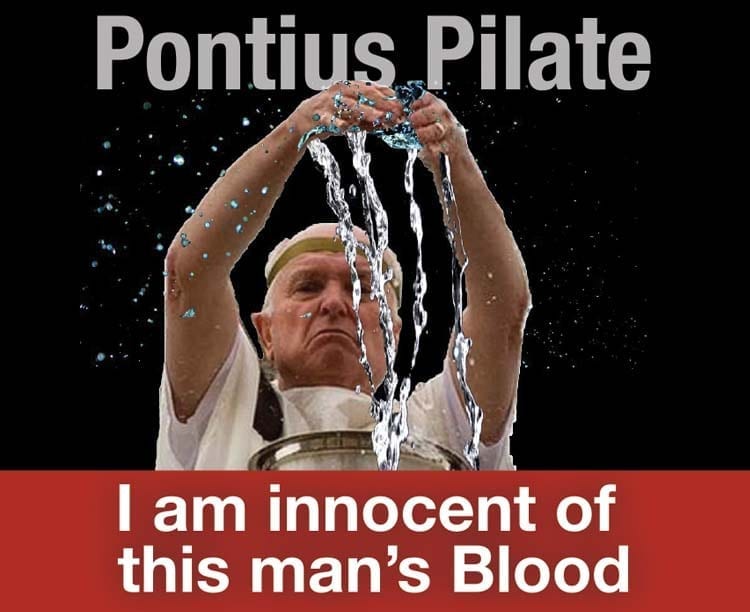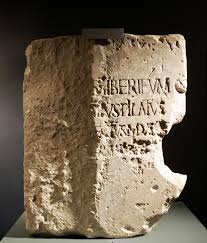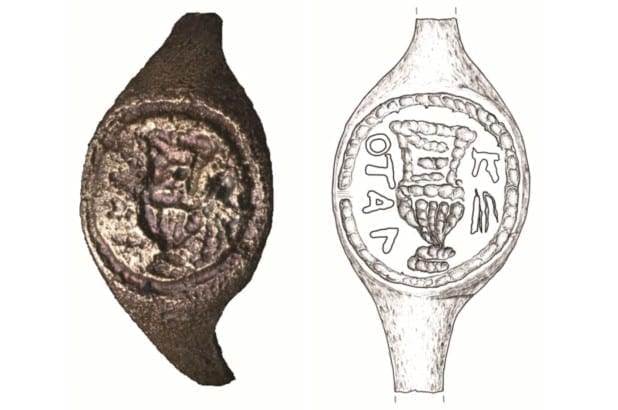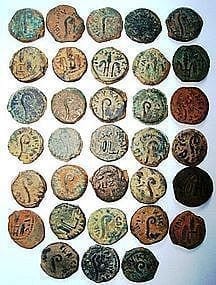Introduction
 Pontius Pilate was the man the Almighty used to change the world. His act of sentencing Jesus of Nazareth to death; the only death acceptable to the Father for the forgiveness of sins, as John the Baptist referred to him: the lamb of God who takes away the sins of the world.[1] Isaiah states as well: The LORD has laid on him the iniquity of us all.[2] The promise God had made four thousand years before; And I will put enmity between you (Satan) and the woman, and between your offspring and hers; he will crush your head and you will strike his heel.[3] was fulfilled at Pilate’s direction.
Pontius Pilate was the man the Almighty used to change the world. His act of sentencing Jesus of Nazareth to death; the only death acceptable to the Father for the forgiveness of sins, as John the Baptist referred to him: the lamb of God who takes away the sins of the world.[1] Isaiah states as well: The LORD has laid on him the iniquity of us all.[2] The promise God had made four thousand years before; And I will put enmity between you (Satan) and the woman, and between your offspring and hers; he will crush your head and you will strike his heel.[3] was fulfilled at Pilate’s direction.
From that momentous decision by an insignificant Roman official two thousand years ago, the ability of Satan to keep people separated from God (spiritual death) as had happened in the Garden of Eden when God expelled Adam and Eve, was broken and Satan’s head was crushed figuratively. Again, figuratively, Satan used the cross to bruise the Messiah’s heel.
For being the man who made the most significant decision in world history, very little was known about him. What we do know of Pontius Pilate comes from the four gospels which provide an outline of his involvement with the crucifixion of Jesus. He is mentioned in non-Christian historical writings as well; by the Jewish historian Josephus (AD 37-103)[4] and Jewish philosopher Philo of Alexandria (25 BC- AD 50),[5] and by the Roman historian Cornelius Tacitus (AD 56-117).[6] However, there has never been any solid archaeological findings that Pontius Pilate, the fifth governor of Judaea, ever existed. The records of his administration had disappeared completely: no papyri, no rolls, no tablets, no (authentic) letters to Rome. The Roman ruins that remained in Israel seemed to have nothing to do with him.[7]
I have written about Pontius Pilate before: https://www.adefenceofthebible.com/2019/03/31/pontius-pilate.
The Pilate Inscription
 However, in 1961 the Italian archaeologist, Dr Frova uncovered a limestone block while he was excavating an ancient theatre near Caesarea Maritima. Although the inscription had been partially removed, enough remained of its Latin writing, which when translated, read; Pontius Pilate, Prefect of Judea, exactly how the gospel writer Matthew described him. Note, Prefect is the Latin title, Governor is its English equivalent. This find was powerful confirmation of the historicity of the Bible. See image.
However, in 1961 the Italian archaeologist, Dr Frova uncovered a limestone block while he was excavating an ancient theatre near Caesarea Maritima. Although the inscription had been partially removed, enough remained of its Latin writing, which when translated, read; Pontius Pilate, Prefect of Judea, exactly how the gospel writer Matthew described him. Note, Prefect is the Latin title, Governor is its English equivalent. This find was powerful confirmation of the historicity of the Bible. See image.
This 600 mm by 900 mm (2 ft x 3 ft) slab was found re-used as a building block in a fourth century remodelling project, but it was an authentic first-century monument, apparently written to commemorate Pilate’s erection and dedication of a Tiberium, a temple for the worship of Tiberius Caesar, the Roman emperor during Pilate’s term over Judea.[1]
Pilate’s ring
 On November 29, 2018, news circulated that a copper-alloy ring had been found at Herodium, the mountain fortress of Herod the Great, bearing the inscription of Pontius Pilate in Greek. The ring had been found by Hebrew University professor Gideon Foerster during the 1968-69 season and it would have been used for sealing documents. However, it was only recently cleaned to reveal its inscription. Its presence at Herodium is explained by Biblical Archaeology Review’s editor Robert Cargill; We know that Pilate used Herod the Great’s former palaces as his own residences in both Caesarea and Jerusalem. Pilate repaired Herodium and it continued to be active during his rule.[8]
On November 29, 2018, news circulated that a copper-alloy ring had been found at Herodium, the mountain fortress of Herod the Great, bearing the inscription of Pontius Pilate in Greek. The ring had been found by Hebrew University professor Gideon Foerster during the 1968-69 season and it would have been used for sealing documents. However, it was only recently cleaned to reveal its inscription. Its presence at Herodium is explained by Biblical Archaeology Review’s editor Robert Cargill; We know that Pilate used Herod the Great’s former palaces as his own residences in both Caesarea and Jerusalem. Pilate repaired Herodium and it continued to be active during his rule.[8]
Pilate’s coins
Coins issued by Pontius Pilate have now become so numerous that it is possible to buy them on eBay.[9] He issued bronze coins known as prutah, from AD 26-36 which was the length of his governorship. Pilate’s coins are Roman coins, the words on them are Greek, they were circulated in Judea, each has the date of issue stamped on it.
The coin collection shown, is for sale with the statement: This collection contains all three different types of Roman Prefect Pontius Pilate coins under Tiberius, 26 – 36 A.D. Found in Judea. In very good condition. Natural patina. Partially cleaned.[10]
Pontius Pilate Road
Another discovery sheds some light on the complex nature of the man who sentenced Jesus to death and committed a barbarous act of mixing Jewish blood with the blood of the sacrifice,[11] as well as using temple funds for the construction of an aqueduct.[12] In October, 2019, archaeologists from the Tel Aviv University and Israel Antiquities Authority announced they have been able to date a well-constructed Roman road which went from the Pool of Siloam to the Temple Mount.[13] The road which was first  uncovered 125 years ago, is 8 metres (25 feet) wide and 600 metres (nearly 2,000 feet) long. The road was of such quality that an estimated 10,000 tons of limestone rock was required to build it. It meant that pilgrims could stop to bathe and get fresh water and then proceed to the Temple Mount for worship.
uncovered 125 years ago, is 8 metres (25 feet) wide and 600 metres (nearly 2,000 feet) long. The road was of such quality that an estimated 10,000 tons of limestone rock was required to build it. It meant that pilgrims could stop to bathe and get fresh water and then proceed to the Temple Mount for worship.
The researchers were able to date the road by excavating under parts of it and collecting 101 coins. Since they were all stamped with their date of issue and all no younger than AD 31, a time when Pilate was governor of Judea. He was the last governor to issue coins before a new ruler moved into Judea at around AD 40 and minted new currency. The researchers found no money from this new ruler in their excavations, an indication that the street must have been completed before those coins were issued. Tel Aviv University archaeologist Nahshon Szanton, the lead author of the study, speculates that Pilate’s construction of the street; may have been to appease the residents of Jerusalem, as well as to aggrandize his name through major building projects.
Image credit: https://en.wikipedia.org/wiki/Jerusalem_pilgrim_road#/media/File:City_of_davidDSCN4613.JPG
Conclusion
As with many biblical places, characters and events, archaeology has afforded confirmatory evidence of their reality. In Pilates’ case, it has provided a deeper insight into the man used by God to play a major role in releasing people from the chains which once bound them.
There are many stories, all of uncertain value and in many cases legendary, telling of Pilate’s later life and of his suicide.
[1] John 1:29.
[2] Isaiah 53:6.
[3] Genesis 3:15.
[4] Antiquities of the Jews 18.3. 3.
[5] https://en.wikipedia.org/wiki/Roman_Procurator_coinage referencing; Philo of Alexandria, The Legatio ad Gaium, trans. with commentaries by E. Mary Smallwood (Leiden, 1961).
[6] Tacitus, Annals, XV 44; see Appendix 2.
[7] Ann Wroe, The Independent; https://www.independent.co.uk/news/people/historical-notes-pontius-pilate-a-name-set-in-stone-1084786.html.
[8] First Person, Biblical Archaeology Review, March/April, 2019, page 6.
[9] https://www.ebay.com/b/Pontius-Pilate-In-Roman-Imperial-Coins-27-Bc-476-Ad/4734/bn_7022551847. http://www.ancientresource.com/lots/holyland_artifacts/holy-land-biblical-coins/pontius-pilate-coins.html. https://www.forumancientcoins.com/catalog/roman-and-greek-coins.asp?vpar=932.
[10] https://www.biblicalartifacts.com/items/809481/33-BRONZE-COINS-PONTIUS-PILATE.
[11] Luke 13:1.
[12] Flavius Josephus, The Jewish War 2.175-177.
[13] Nahshon Szanton, Moran Hagbi, Joe Uziel and Donald T Ariel, Tel Aviv: Journal of the Institute of Archaeology, Volume 46, Issue 2, 2019.
